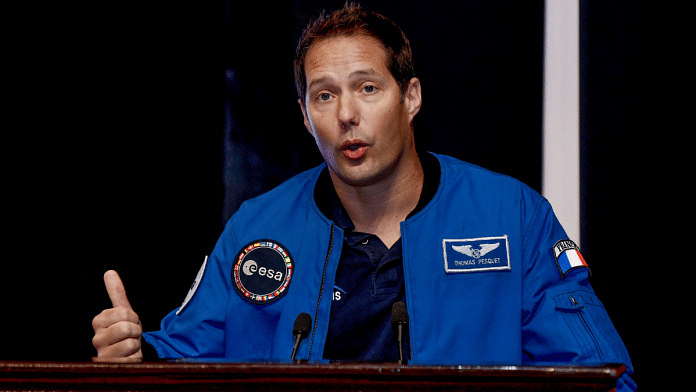New Delhi: European Space Agency engineer and astronaut Thomas Pesquet dreams of a day when he can blast off into space with an Indian astronaut. This goal is one step closer to reality after private space industry bodies from India and France forged an alliance to enhance business collaboration in the sector Monday.
The Indian Space Association (ISpA) — an industry body of space companies — signed an Memorandum of Understanding Monday with French aerospace industries body GIFAS to enhance the understanding of space industry capabilities and increase awareness of business opportunities between the two countries. The agreement was signed on the first day of the two-day Indian Space Conclave held at the Manekshaw Centre in New Delhi.
“The collaboration will help foster sustainable growth, promote innovation and advocate adoption of new technologies in France and India space industries. The MoU will act as an extension to the already flourishing Indo-French relationship in the space sector and augment the individual and collective membership bases of the organisations through the benefit of greater international linkages for the members,” ISpA said in a statement after the conclave.
Over 500 delegates from India and France attended the event.
Addressing delegates at the event, Pesquet said Chandrayaan-3’s success has opened the world’s eyes to India’s capabilities.
Organised by ISpA, the two-day conclave will go on until Wednesday. ISpA is also organising an exhibition that will see 24 space startups and institutions participate.
ISRO chairman S. Somanath was not physically present at the conclave but gave a video address hailing the “significant milestone” that will open new frontiers and boost innovation.
“This conference, with the active participation of both public and private stakeholders, will be a crucible for thought leadership. As we engage in profound discussions on sustainable development, disaster management, business domains, and geospatial policy, we recognise the transformative potential that the space sector holds for the betterment of humanity,” he said.
Also Read: How space collaboration with US could help India breach next frontier — human spaceflight & beyond
‘Commitment to strengthening industry collaboration’
Describing France as a “crucial partner in our space exploration endeavors”, Indian Space Association’s director general A.K. Bhatt said the MoU with GIFAS “reaffirms our commitment to strengthening industry collaboration between our two nations”.
Pesquet, quoted earlier, also said India is on the cusp of achieving the milestone of sending human beings to space through ISRO’s crewed orbital mission, Gaganyaan.
“I know first hand the difficulties of human space exploration. I also know the rewards. There is nothing more impressive than shooting a human into space,” he said at the event, adding that space technology is going to be at the forefront of the fight against climate change.
Cédric Post, GIFAS deputy director international, European and commercial affairs, said that the MoU signed with ISpA “underscores our shared commitment to strengthening industry collaboration and fostering an environment of innovation, business development, and sound policy regulation”.
Indo-French space collaboration has achieved significant milestones in recent years. Both nations have joined forces for India’s ambitious human spaceflight initiative Gaganyaan, with France contributing to areas like space medicine and astronaut health as well as supplying flight systems.
France is collaborating with ISRO’s for India’s Venus mission in 2025. ISRO is also working with its French counterpart CNES on the TRISHNA mission (Thermal infraRed Imaging Satellite for High-resolution Natural Resource Assessment — a satellite intended to measure twice a week the thermal infrared and optical signal of the surface-atmosphere system globally.
The satellite is set to be launched at the end of 2024 or beginning of 2025, with a mission duration of at least 5 to 7 years.
A previous version of the report said Chandrayaaan-2. That has now been corrected. The error is regretted.
(Edited by Uttara Ramaswamy)
Also Read: ISRO wants to send civilian scientists, doctors to space to research microgravity



